For the last several weeks, the national political debate has been focused on the “Veepstakes;” the time every for years when the nation waits to see who each major party’s nominee will select as their running mate. The issue of picking a vice president often comes down to politics. Candidate’s try to pick candidates that will appease a certain segment of the party’s base, or appeal to swing voters, or a specific state. In 2016, Trump opted to pick an establishment and evangelical choice in Mike Pence, the Indiana Governor. Despite some rumblings, Trump appears to be clearly running with Pence in 2020. Democratic nominee Joe Biden seems poised to announce his running mate in the next week.
As the press and pundits talk about the Veepstakes, the issue of “ready to assume the office if needed” is a common line. The issue rarely comes up as most choices in recent history (exception: Sarah Palin) have faced little to no question of their ability to assume the office on day 1 if needed. History is filled with terrible choices for Vice President, many of whom you never heard of. However, in recent years, with the knowledge that 8 Presidents have died in office, and 1 resigned, the major party candidates have made sure to pick Vice Presidents who’s credentials to lead are hard to question.
With that in mind, it is worth looking at what may well have been the most consequential Vice Presidential selection in not just American History, but World history.
The 1944 President Election
By 1944, Franklin Roosevelt was in his third term as President and WWII was still raging in Europe and the Pacific. Roosevelt ran for a 4th term with a desire to see the war to its conclusion and Democratic leaders did not want to risk loosing to a formidable Republican ticket. However, many expected that Roosevelt, who was getting more frail, would not survive another term.
The Problem with Hendry Wallace
In 1940, Roosevelt had gotten a new Vice President, Henry Wallace. Wallace, Roosevelt’s Agriculture commissioner before 1940, was an outspoken progressive that made party leaders uneasy, but Roosevelt had demanded his inclusion on the ticket. Wallace’s anti-segregation stances angered Southern leaders, while his new age beliefs and cozy relationship with the USSR made remaining Democratic leaders uneasy. Despite concerns from party insiders, Roosevelt got his way and Wallace won the Vice Presidential Roll call. Wallace beat Speaker of the House William Bankhead, of Alabama.

Wallace proved to be a liability on the 1940 ticket. Letters Wallace sent to Russian mystic Nicholas Roerich risked damaging the campaign. The only way the GOP was stopped from releasing the letters was Democratic threats to reveal that Wendell Willkie was having an extramarital affair. (Here more about this in the Wicked Game podcast).
The national ticket won, but Wallace was never embraced by Democratic Party leaders. Wallace’s term as VP did not help matters. As American entered WWII, Wallace’s views of the Soviet Union became a problem. While American was in an alliance with the Soviets, there was a clear understanding about the horrors of the Stalin regime and anti-communism was still a strong force in American politics. Wallace, however, had a very naive view of the Soviet Union. He had visited in 1943 and the Stalin’s Government had made sure to orchestrate the camps he saw and regions he visited to hide their crimes of the gulags and the condition of the POW camps. Wallace remained a defender of Stalin and Soviets after the trips.
For party leaders, Wallace was an unacceptable option for 1944. The prospect that FDR might die in office weighed on the minds of party leaders. After much negotiation, party leaders got Roosevelt to agree on running with Harry Truman, the Senator from Missouri.
Harry Truman’s Political Rise
Machine Politics and County Judge
Truman’s start in politics began with his WWI service. It was during the war that Truman became friends with Jim Pendergast, nephew of Tom Pendergast; the powerful Kansas City Democratic boss. This connection resulted in Truman being asked to run for county judge in 1922. To clarify though, County Judge was more like a county commission (misleading name). Truman slated to run for the eastern district; which represented the more county outside of Kansas City. Jackson County had three elected judges (commissioners): A county-wide Presiding Judge, a Kansas City-based West Judge, and a rural East Judge. The East/West divide was entirely geographic and in no way equal in population.
Truman first had to get through the democratic primary. The primary itself was part of a battle between different factions in Kansas City Democratic politics. Pendergast’s machine was known as the “goats” – while a rival faction controlled by future-Congressman Joe Shannon, was known as the “rabbits.” These were not just insider terms; they mattered a great deal and were frequently used in the papers. The two factions had been feuding since the early 1900s and while they made alliances at times; internal fighting could also lead to GOP victories in Jackson County. One key part of goat-rabbit alliances was the 50-50 rule; which mean each side got half of the patronage positions given out by the politicians they elected. Shannon had originally feuded with James, but by the 1920s he was beginning to lose the war to Tom.
In the 1924 County Judge Democratic primary elections, Pendergast and Shannon made deals for two of three offices. The countwide race for “Presiding Judge” saw rabbit-faction Elihu Hayes as the machine’s nominee. Meanwhile, the Kansas-City-based western district nomination was given to H.F. McElroy, a goat. The eastern district was where the two factions agreed to “fight it out” (as they’d often say). Early returns showed it was too-close-to-call for several days as Truman, the goat candidate, narrowly led rabbit E. E. Montgomery. It wasn’t until the Saturday canvass that Truman was declared the winner by 282 vote margin: 4,227 to 3,945.
Truman would go on to win the general election for the eastern district; taking 57% of the vote. The Democratic slate would sweep many offices in Jackson County that year. However, just two years later, as Calvin Coolidge rocketed to a landslide election for President, the Jackson County Democrats would get wiped out. Truman and many Democratic officials lost their re-election.
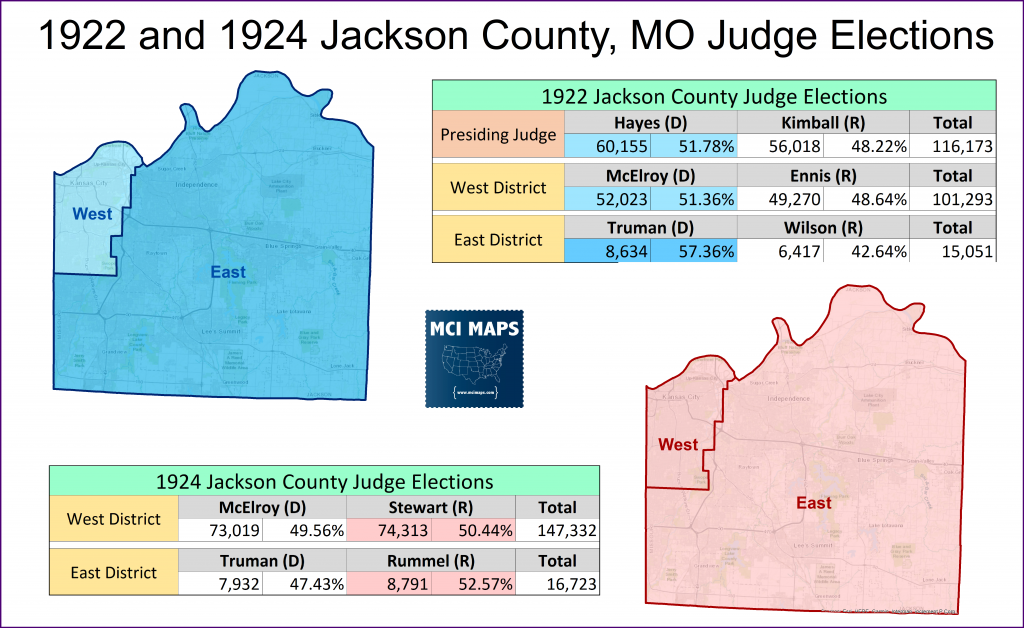
The GOP wins in Jackson County in 1924 were part national headwind but also thanks to cracks in the Goat-Rabbit alliance. Truman did not want to honor the 50-50 deal and Shannon, in revenge, worked to oust Truman in the election by forging an alliance of his Democrats and Republicans. Truman did take part in patronage out of loyalty to Pendergast, but he expressed reservations at times.
Shannon took aim at both Truman and McElroy (who was much more of a Pendergast lacky). His goal was to knock off one of the Democrats and forge an alliance between the Republican and Presiding Judge Hayes (who was not up for re-election). The plan backfired when Republicans won both judgeships, and with control of 2/3 of the posts, didn’t need Shannon.
Truman rebounded quick, however. In 1926 he was approached by the Pederast’s machine, which has consolidated more control over the party in wake of Shannon’s mistakes, to be the nominee for Presiding Judge. Truman was seen as a good compromise pick because he was a goat, but not seen a Pendergast lackey. Truman accepted and faced no primary opposition. In the general, he won 77,680 to 61,466; a night where Democrats swept offices in Jackson County; including the East and West districts.
Truman was up for re-election in 1930, a major Democratic wave during the Great Depression. Jackson County democrats swept races in landslides. Truman won re-election 108,509 to 50,650; a 2-1 margin.
Senator Truman
In 1934, Truman approached Pendergast about running for Congress; however, the machine boss turned him down. However, Pendergast settled on Truman to be the machine’s candidate for US Senate after the boss’ original choices backed out. Pendergast put his machine to work to cause a huge surge in Kansas City. Truman faced two congressman, Jacob Milligan of the NW end of the state, and John Cochran of St Louis. Both Cochran and Milligan ran as anti-Pendergast candidates, but Cochran did a better job consolidating that vote. In the end, however, Truman’s 136,000 net vote lead out of Jackson county carried him to victory.
The scale of Truman’s Kansas City margin cannot be overstated. Truman got 79% of the total votes cast for FDR in the Presidential election two years earlier. And this was a midterm primary being compared to a general election for President. Pendergast used his machine to get out votes in the county – and quiet possibly engaged in some ballot stuffing as well. The St Louis machine is likewise believed to have engaged in ballot stuff for Cochran that same year.
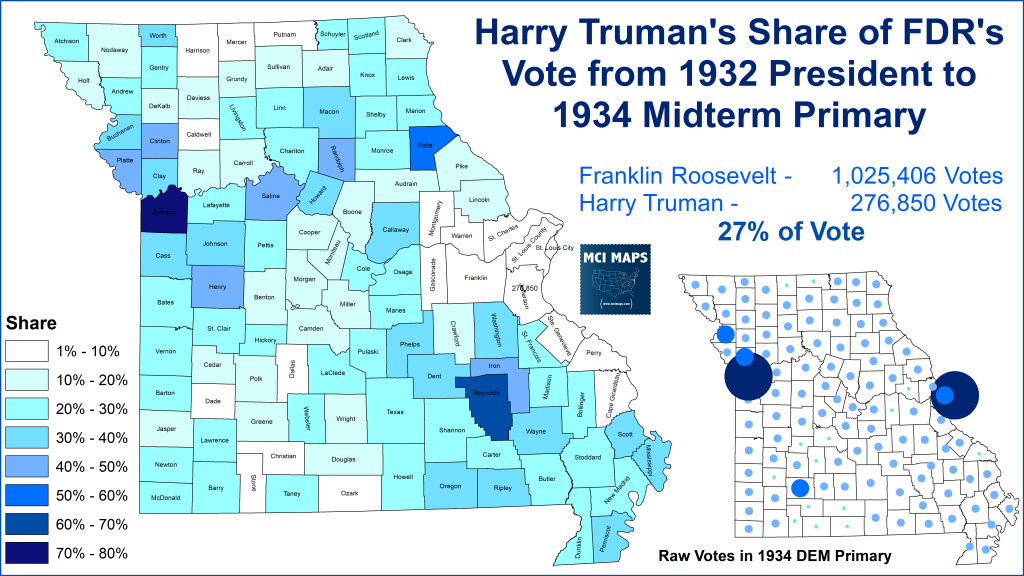
Once he was the nominee, Truman faced little trouble in the general election. 1934 was a rare midterm that was good for the incumbent Party. Democrats made gains across the state and Truman easily won with 59% of the vote.

Over the course of his first term, Truman learned the ins and outs of the senate. But in Kansas City things radically changed. The Pedergast machine had grown out of control and its corruption and violence could no longer be ignored. Treasury Secretary Henry Morgenthau began to investigated Pendergast and his mob ties. Incumbent Governor Lloyd Stark, originally an ally, flipped on him. Pendergast began to suffer ill health as well and his hold on power quickly fell away from him. He was arrested for tax evasion in 1939 and sentenced to 15 months in prison.
With Pendergast gone, Truman faced a steep challenge in 1940. Stark opted to challenge Truman in the primary. They were joined by Maurice Milligan, a district attorney who had prosecuted Pendergast. Both split the anti-Truman vote, however. Truman won with a much smaller Kansas City margin; a reflection of the machine’s collapse. However, Truman had also expanded his support into rural counties and made an alliance with the St Louis boss; allowing him to take the city proper.
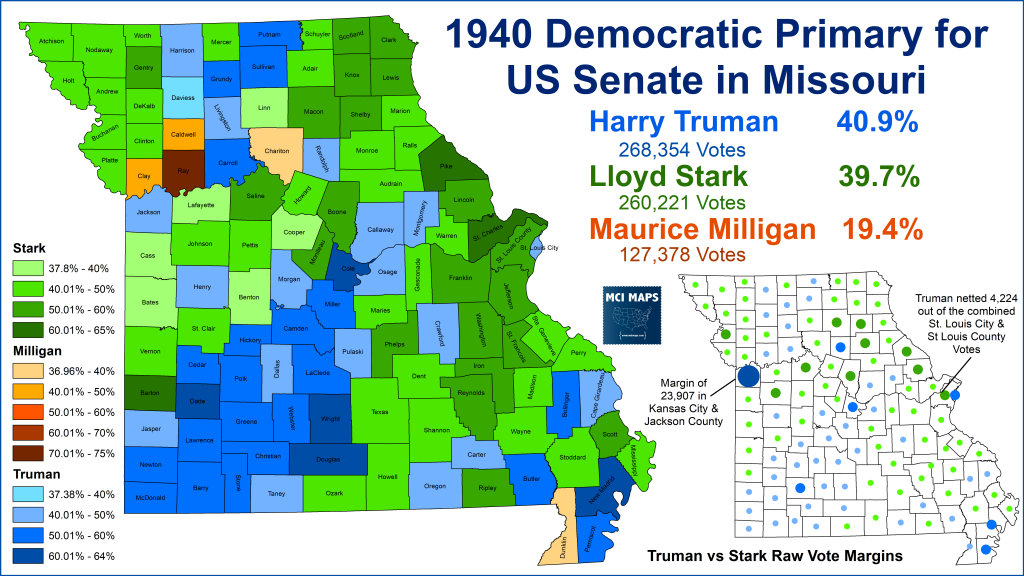
Truman faced a close election in the general, but did prevail by 2.5%. His win came as FDR won the state by 5 points. Both candidates ran close together, with FDR outperforming the most in the St Louis suburbs. However, residual anti-Pendergast sentiment did not seem to taint Truman too much in the general. Many voters cast straight-ticket ballots.
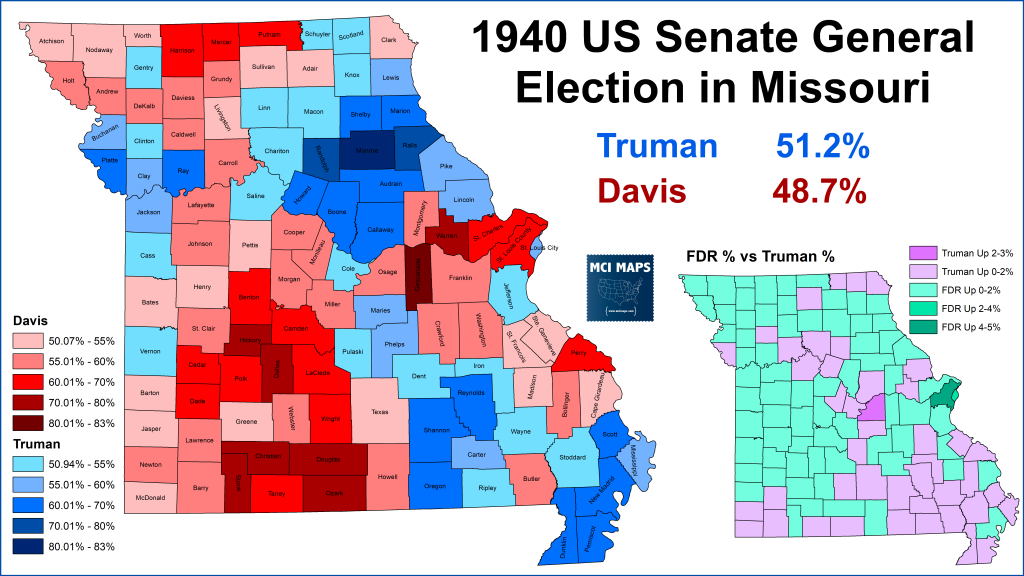
Truman managed to survive Pendergast’s collapse. He was certainly aided by never being especially close to the boss to begin with. Truman moved on after the election and eventually came to head the Truman Committee; which made him nationally famous for its role in investigating waste in the war effort. The committee work was instrumental in elevating Truman by 1944 to be a VP contender. The press loved the committee and Truman was even featured on the cover of Time Magazine. Truman’s work on the committee, which saved billions in waste but also gave discretion. When the committee was inquiring about huge sums being spent on a vague project, the Defense Department met with Truman and others to assure them the details had to be secret but they were for legit classified war-effort work. Truman agreed not to pursue the matter. As you can probably guess, these were the funds being spent on the Manhattan Project.
The 1944 Democratic Convention
Heading into the convention, Roosevelt stated he still preferred Wallace, but party leaders made it clear Wallace could not be the nominee. By the summer of 1944, the push against Wallace hit a fevered pitch. Wallace still had 65% of Democrats supporting him staying on as Vice President and had at least 1/3 of delegates loyal to him. FDR was convinced by party leaders that Wallace had to be replaced and his staff informed the VP that the President could not demand him at the convention. FDR did write a letter for Wallace saying that if were personally a delegate, he’d vote for Wallace. This was both seen as a endorsement and a blow-off by different people. Wallace and many of his backers indeed felt FDR was trying to let Wallace down easy but would not stop the Democratic bosses from stopping his re-nomination at the convention. Party leaders found Truman to be a good compromise choice. One of the biggest backer of Truman was DNC Chair Bob Hannegan.
As the convention got closer, there were three top candidates for the Vice Presidency. Party leaders had gotten FDR to sign off on Truman as the pick, though the President was by and large still staying out of the fight. Wallace, meanwhile, made it clear he would go to the convention and fight for the nomination. In addition, White House staffer James Byrnes, a major player in the war effort, was running as well. Byrnes was encouraged at first to run by FDR and had support in the south. Through this process, FDR was very cagey on the VP race and contradicted himself more than once.
The Democratic Convention was held in Chicago; with the formal days of operation being Wednesday through Friday (July 19-21). Maneuvering began in the town days before. Byrnes’ VP chances were torpedoed when labor leader Sidney Hillman made it clear he and labor would not accept him as VP. Byrnes dropped out, believing FDR had labor kill his chances (though no evidence of this exists). Truman played dumb through most of this, claiming he had no interest at being VP. He originally stated he had no interest in the nomination, but party leaders sat with the Senator in a suit and FDR called; making it clear Truman was to be the pick.
The Wallace campaign was well aware of the maneuvering going on behind the scenes. Their aim was to storm the convention and fill the rafters with supporters. The goal was simple, demonstrate such uniform supports that the impressionable delegates would swing to him.
Nominations were supposed to take place on the 2nd night, Thursday, and he appeared favored to win the nomination. However, the chair of the convention, sensing the Wallace momentum, abruptly ended the days proceedings. Another 24 hours of calls, arm-twisting, and deals took place. Proceedings resumed Friday.
When the first roll call happened, Wallace still lead, but far short of a majority.
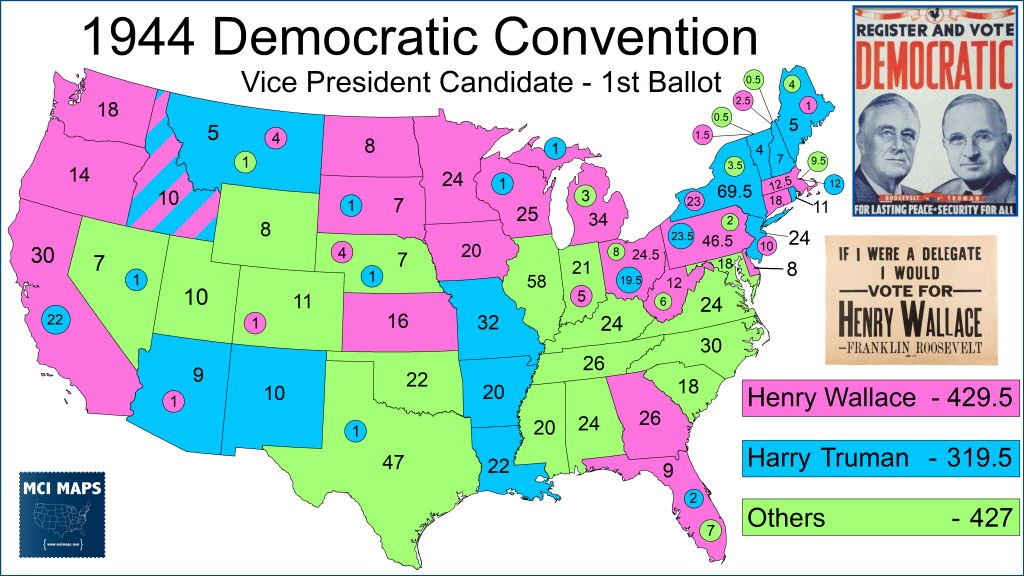
Wallace was strongest in the Midwest and West Coast, but Truman had a good deal of the New England and New York delegation. The Southern delegates were split between Truman and other candidates. However, after the 1st ballot, Alabama Senator John Bankhead dropped out to back Truman. In addition, many delegates voting for favorite sons and assorted lesser-known candidates moved into Truman’s column after the first ballot.
The second ballot put Truman ahead of Wallace, though still short of a majority.

More of the Southern delegates came on board for Truman while Wallace picked up a handful more delegates, largely from the Texas delegation.
Sensing the end was near for Wallace, delegates across the board started shifting their votes to Truman before the 2nd ballot was finalized and a third ballot had to take place. A stampede to Truman took place as states changed their votes, resulting in an overwhelming win.
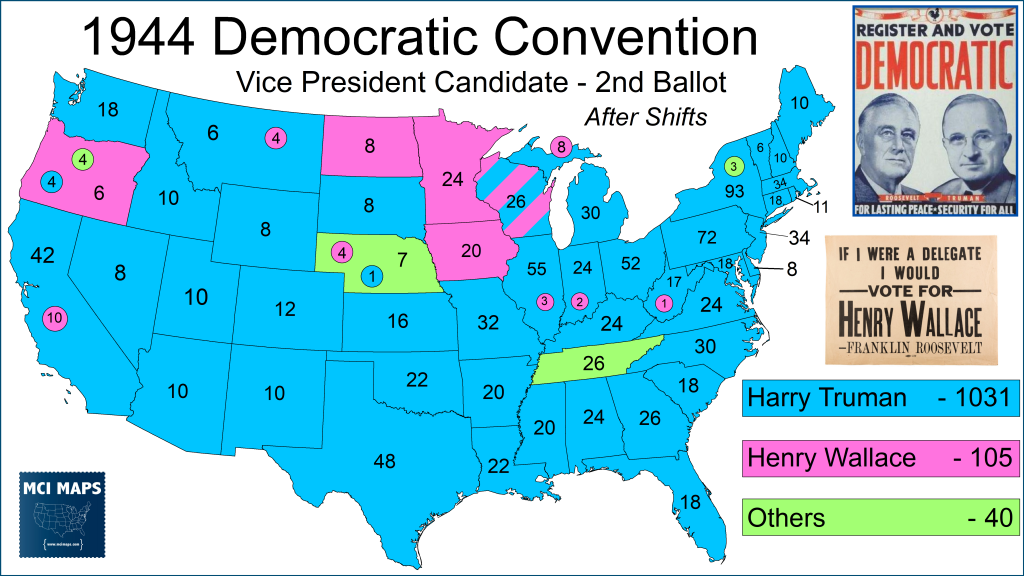
Most state delegates went entirely into the Truman column, with only a few holding out for Wallace or other assorted candidates. This made Truman the nominee, and eventually, the President.
Consequences
As stated before, Wallace had a sympathetic view toward the Soviet Union, while Truman was a stringent anti-communist. Some argue that had Wallace been President, the cold war would not have happened. However, a more accepted historical assessment is that a Wallace Presidency would have resulted in an unchecked USSR expanding its territory further into Europe and possibly Asia. Any future President aiming to limit USSR influence would have been dealing with a more powerful adversary. Truman’s efforts at containment and the Marshall Plan’s efforts to rebuild post-war Europe would not have occurred. Wallace ran for President in 1948 as the “Progressive Party”s nominee. However, his campaign came under fire as a vehicle for the Communist Party of America, and Wallace’s unwillingness to denounce the community party hurt him with mainstream liberals (resulting in him finishing with under 3%). In the 1950, Wallace admitted he had been naive about the true nature of the USSR, famously publishing the book, Where I was Wrong. By 1952, Wallace had become a strong anti-communist. Maybe Wallace would have come to the realization about the USSR during his Presidency, maybe not. The stark differences between a Truman and Wallace Presidency in the post-war era does give strong credibility to the argument that the 1944 Convention was one of the most important in history.


